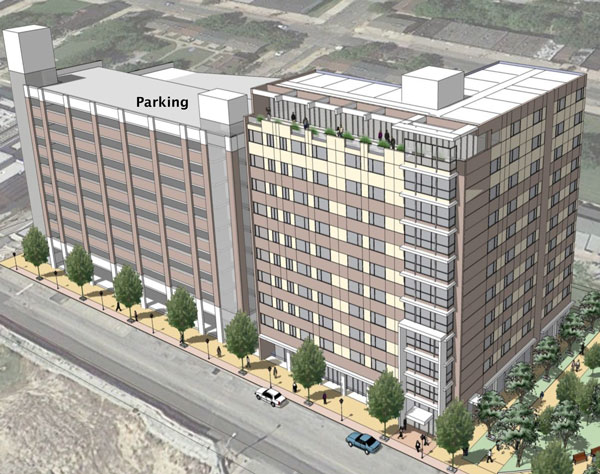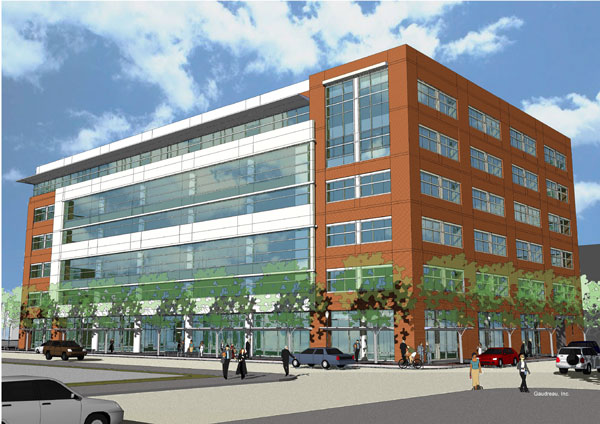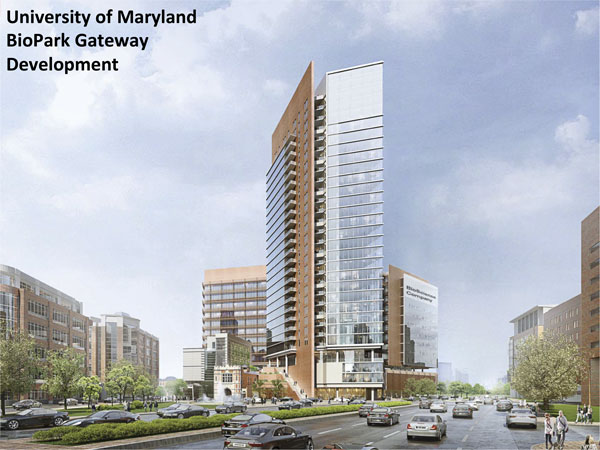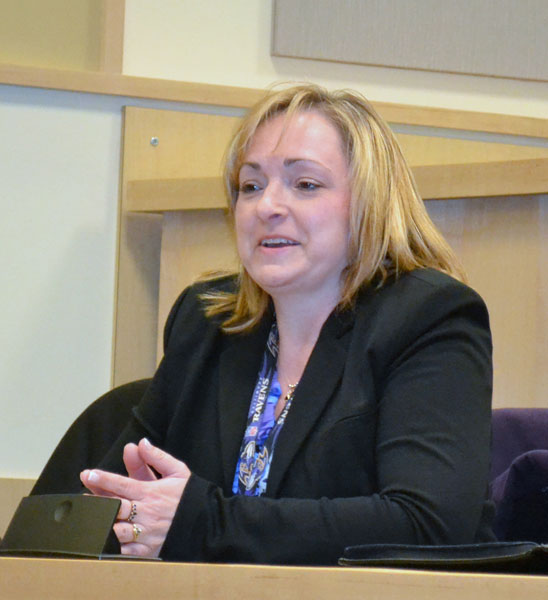President's Q&A, April 2014
Dr. Perman held a group Q&A session on April 17 at Hosick Lecture Hall in the Bressler Building. James L. Hughes, MBA, chief enterprise and economic development officer and vice president, began the session with an update on the University of Maryland BioPark’s new Master Plan. Excerpts of that and questions and answers that followed appear below.
 Mr. Hughes: The BioPark Corporation has acquired about 12 acres of land and plans to develop up to 2 million square feet of space. From a development standpoint, we’re about 30 percent there in meeting our vision. At the core of the BioPark is a group of three-dozen tenants and more than 650 employees focusing on diagnostics, therapeutics, and devices.
Mr. Hughes: The BioPark Corporation has acquired about 12 acres of land and plans to develop up to 2 million square feet of space. From a development standpoint, we’re about 30 percent there in meeting our vision. At the core of the BioPark is a group of three-dozen tenants and more than 650 employees focusing on diagnostics, therapeutics, and devices.
Following the lead of other cities, we want the BioPark to be more than a collection of biotech companies. Rather we see it as a place where people congregate, with retail and destination spots and the streets alive with energy. Our ideas for creating an integrated mix include:
Transportation-Oriented Development
The Baltimore Red Line project plans include an underground station near the corner of Martin Luther King Jr. (MLK) Boulevard and West Baltimore Street. That would be a great asset for people to live here and walk to jobs at the University and the BioPark, and also will allow access to the Inner Harbor. Dr. Perman has been one of the great civic leaders in pushing for this. Since billions of dollars are involved, there is competition across the country for major rail projects, and one of the calibrations they make in Washington, and at the state level is: who wants this project? We are working with the mayor, the governor, and the Department of Transportation to lobby for the Red Line.
Maryland Proton Treatment Center
The School of Medicine’s Department of Radiation Oncology was the driver in the development of the Maryland Proton Treatment Center. The building is being constructed by a private developer with projected costs of $200 million, to create the first proton therapy center in the Greater Baltimore-Washington area, and one of only a dozen in the country. It’s going to be another 18 months before our physicians start treating patients there, but the expectation is 2,000 patients a year will receive treatment at this facility.
Extended Stay Hotel
 Patients undergoing treatment at the new Proton Center will spend 45 minutes to an hour per day for four to six weeks in the facility, so patients and their families need a place to stay nearby. The BioPark Corporation is negotiating with a developer to plan a 167-room extended stay hotel, which would have a kitchenette, a living room area — comfortable amenities for a long-term stay. The hotel will serve not only the Proton Center, but the BioPark, the University, and the neighborhood, which is very excited about it. It’s not a done deal but we’re very optimistic and hope to open it in 2016, within six months after the Proton Center starts treating patients. It will have conference facilities, a small pool — a very nice hotel.
Patients undergoing treatment at the new Proton Center will spend 45 minutes to an hour per day for four to six weeks in the facility, so patients and their families need a place to stay nearby. The BioPark Corporation is negotiating with a developer to plan a 167-room extended stay hotel, which would have a kitchenette, a living room area — comfortable amenities for a long-term stay. The hotel will serve not only the Proton Center, but the BioPark, the University, and the neighborhood, which is very excited about it. It’s not a done deal but we’re very optimistic and hope to open it in 2016, within six months after the Proton Center starts treating patients. It will have conference facilities, a small pool — a very nice hotel.
Innovation Center
 The next thing we’re working on, that we hope will also open in early 2016, is our next commercial building. Plans are to include a new Innovation Center that will host companies in a variety of technology fields such as infotech, engineering, solar energy — that sort of cutting-edge technology. We’ve been talking to Under Armour and they’ve said great, we’d love to be there, and we’d like to work with the engineers at College Park and attract their graduates here to develop the next generation of sportswear. This building also will include lab space to help build additional companies.
The next thing we’re working on, that we hope will also open in early 2016, is our next commercial building. Plans are to include a new Innovation Center that will host companies in a variety of technology fields such as infotech, engineering, solar energy — that sort of cutting-edge technology. We’ve been talking to Under Armour and they’ve said great, we’d love to be there, and we’d like to work with the engineers at College Park and attract their graduates here to develop the next generation of sportswear. This building also will include lab space to help build additional companies.
Impact Hub
Our School of Social Work and other schools have been generating wonderful nonprofits that are combining entrepreneurship and social enterprise. We’re looking at creating a cluster here in the next building where we could bring together those companies and organizations and drive things forward. Also, we have a handshake agreement with a local food market cafe and deli that will locate on the ground floor. So again, not quite a done deal, but we hope in the next six months this will be under construction and open in 2016.
BioPark Gateway Development
 The biggest step, and potentially the most dramatic for the skyline, is building what we’re calling the BioPark Gateway Development for now. It’s a 30-story residential building, which would contain as many as 300 residential units, along MLK Boulevard. We’re envisioning a retail element including multiple restaurants, a parking garage, the residential building, and literally on the higher floors, there will be harbor views. We also have integrated into that complex a commercial building just to the north, and this could be as big as 400,000 square feet. I keep saying these aren’t done deals. The way the BioPark is structured is the University, or nonprofit that we’ve set up, owns the land, and then we go out to private developers to build the buildings. We have already had $400 million in private investment in the BioPark. We’re taking this Gateway Development concept to private developers, private investors, and saying this is where you should invest your money.
The biggest step, and potentially the most dramatic for the skyline, is building what we’re calling the BioPark Gateway Development for now. It’s a 30-story residential building, which would contain as many as 300 residential units, along MLK Boulevard. We’re envisioning a retail element including multiple restaurants, a parking garage, the residential building, and literally on the higher floors, there will be harbor views. We also have integrated into that complex a commercial building just to the north, and this could be as big as 400,000 square feet. I keep saying these aren’t done deals. The way the BioPark is structured is the University, or nonprofit that we’ve set up, owns the land, and then we go out to private developers to build the buildings. We have already had $400 million in private investment in the BioPark. We’re taking this Gateway Development concept to private developers, private investors, and saying this is where you should invest your money.
Dr. Perman: So how’s that for institutional ambition? Make no small plans. What kind of questions or suggestions do you have for Jim?
Q: So when should we start moving in over there?
Mr. Hughes: Actually, if you want to move, we can show you some homes there that come with incentives. The BioPark will write you a check for $2,500, and the city will write you a check for $2,500. In the last two to three years, we’re getting a lot of movement, with townhouses selling for $100,000 to $200,000.
Q: What’s the timeline for the skyline?
Mr. Hughes: The residential building poses the biggest questions. I’d like to think we can build that without the Red Line [transportation project]. But residential developers would like to see the Red Line more definite, and construction on that is supposed to start 12 months from now. So they’re spending tens of millions designing it, but I think once construction starts for the Red Line, that’s probably when we’ll be able to get a residential developer to build that building.
 Q: Is there a thought, as the BioPark develops and expands, that the University will grow into that area and become a larger university?
Q: Is there a thought, as the BioPark develops and expands, that the University will grow into that area and become a larger university?
Mr. Hughes: The University has been an anchor tenant for the first couple BioPark buildings and now is for the Proton Treatment Center. We don’t have any plans for the University to take additional space. One aspect of when the University does take space there, it costs money, so we have to rent the space. So that is less of a driver moving forward. But that interaction between the researchers and the academic researchers and industry is very attractive to the companies who are moving there.
Dr. Perman: We want to be a driver for economic development of the state by attracting private money.
Q: Jim, can you discuss our relationship with the community in regard to the BioPark?
Mr. Hughes: Our orientation with the BioPark from the beginning was that we have a concept, but we’re only going to do it if the community wants us to. And we also said to the community, here are some initial thoughts, what do you think? We took people from the community on a bus with us to a Montgomery County biopark and said this is what we’re envisioning. How do we adapt this? So we spent a lot of time working at it. What’s been great has been that any time we’ve gone to the city for approvals, we have 20 people from the community come with us, all of whom want to speak on behalf of the project. So we’ve been very fortunate. But we’ve also worked hard to maintain that. Jane Shaab [assistant vice president for economic development] is in community meetings with people at least once a week.
Q: Jim, I remember early on in the BioPark process, there was one resident in particular who didn’t want to sell so there was one home surrounded by the bigger buildings. The master plan that you showed us, is that ground vacant or are there some steps that have to be taken?
Mr. Hughes: We’ve not used eminent domain to take people’s houses. We have mostly acquired commercial property, and if somebody wants to sell, we buy. We’d been initially thinking of a different site for the Proton Center and the people who owned the site didn’t want to sell, so we changed our plan. So we’ve worked through that.
Q: The gateway building is pretty impressive. The first thing I thought of was, at 30 stories, is there any problems with the helicopter pad at Shock Trauma?
Mr. Hughes: I think we’re in good shape because we’re out of the flight path there.
Q: Has there been any thought about, or is there the potential for pedestrian walkways, bridges, or tunnels?
Mr. Hughes: If you go back to early master plans, we had a bridge crossing MLK. But the governor does not believe in pedestrian bridges and the city has taken down a number of pedestrian bridges downtown. We do have some plans to extend traffic lights and make MLK more pedestrian friendly, but no, we don’t have a tunnel or bridge in the offing.
Q: Do you have a sense of potentially how many jobs will be created, and of those jobs, is there a set aside for community members?
Mr. Hughes: So far the BioPark employers have 650 employees. By the time we’re done, we’re probably looking at 2,500-3,000 jobs. We don’t have a specific set aside. These are private companies and they’re hiring who they want to hire. We have done a couple things, however. By going to the Baltimore City Community College and getting it to put a major branch here, we have the 38,000-square-foot facilities of BCCC training 600 people a year. Most companies in the BioPark have BCCC interns, and several have gone on to hire BCCC grads.
Q: Will you give us the name of that place in Boston that helped inspire our master plan?
Mr. Hughes: Yes, it’s the Cambridge Innovation Center.
Dr. Perman: The CIC is great for a pediatrician like me who likes to be with children, because you walk in there and everybody’s writing on the walls. It was very inspiring to me to see everybody just use the walls to think out their ideas, calculate what they needed to calculate. It’s exciting.
Dr. Perman: What else is on your mind? Any topic.
 Q: Thank you, Dr. Perman, for making yourself available to us regularly. I remember when I was interviewing at different medical schools across the country, most tried to sell me on the idea of having a student clinic. And while I’ve received an education here I couldn’t have dreamed of elsewhere, I haven’t seen a UMB student clinic yet. I know that, at UMB, we could create something unique, because we have multiple health professional schools on one campus. So I was wondering, how can that interdisciplinary student clinic get started? Are we in the process of creating one already?
Q: Thank you, Dr. Perman, for making yourself available to us regularly. I remember when I was interviewing at different medical schools across the country, most tried to sell me on the idea of having a student clinic. And while I’ve received an education here I couldn’t have dreamed of elsewhere, I haven’t seen a UMB student clinic yet. I know that, at UMB, we could create something unique, because we have multiple health professional schools on one campus. So I was wondering, how can that interdisciplinary student clinic get started? Are we in the process of creating one already?
Dr. Perman: Thank you for your question. We have a variety of clinical activities that are offered by the various schools within the community, but they don’t rise to the level to which I think you’re referring. The idea of an interprofessional student clinic, where students from each of the schools can care for patients together in an interprofessional way, overseen by volunteer faculty, is an admirable goal. We’re discussing that as part of our Center for Interprofessional Education. For now, it probably can be best done under the aegis of AHEC, the Area Health Education Centers. The kind of experience that you’re talking about is what our students do when they’re out in the rural AHECs, and they come together as pharmacists, nurses, medical students, dentists, and the like. We have to create the same kind of opportunity within the city.
Q: Could you describe what’s going into the big hole next to the dental school?
Dr. Perman: What is being built in that area is Health Sciences Facility (HSF) III. This is going to be a 10-story, 429,000-square-foot new building, probably the largest facility of its kind ever built in the state of Maryland to expand our footprint and in which we can accommodate biomedical researchers. It will be largely occupied by School of Medicine faculty and one could envision scientists from other parts of the campus also using it. This biomedical research facility will open in late 2017.
Q: I was wondering if you had any comments about the recent legislative session.
Dr. Perman: First of all, I was encouraged by the continued commitment to completing HSF III, which was our major capital request. That was terribly important. We took a little hit collectively as a system, which then trickles through the universities. Having said that, in the final analysis, the legislature funded an increase in support of higher education, so the University System of Maryland, and therefore the University of Maryland, Baltimore, received an increase in funding compared to previous years. There are not a great many states in which a president of a public institution of higher education can say that. So we were able to give out COLAs and merit increases, with another round of merit raises on July 1 and COLAs expected on Jan. 1, 2015. It’s catch-up time now after previous furloughs, and the legislature was very supportive of that.


